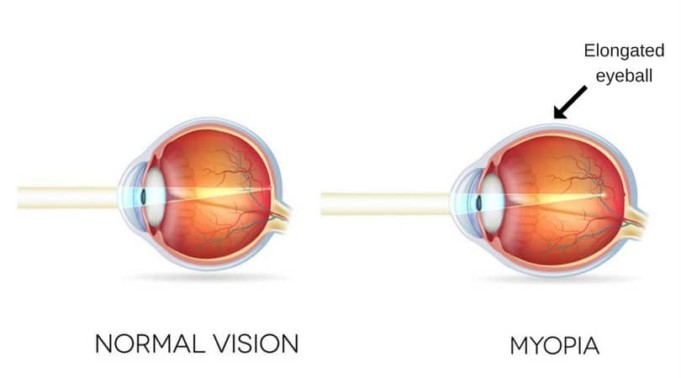Nearsightedness is a prevalent eye condition in which a person can clearly see objects that are nearby but struggle to see faraway objects as they appear fuzzy or blurry. Nearsightedness is also known as myopia.
Nearsightedness, as mentioned earlier, is a widespread condition, but it is also treatable. According to information from the American Optometric Association, about 30 percent of Americans have nearsightedness.
What are the symptoms of Myopia or Nearsightedness
The most apparent symptom of myopia is a blurry vision when a person looks at faraway objects. Children who have myopia may find it difficult to see the whiteboard or blackboard at school.
Adults with myopia may not be able to see street signs while driving clearly. Other signs of myopia include:
- Headaches
- Squinting
- Eyes that hurt or feel tired
The symptoms of myopia will generally go away after a person has been treated with contact lenses or eyeglasses. Eye fatigue and headaches may linger for one or two weeks as you try to adjust to your new contact lens or eyeglass prescription.
Risk Factors for myopia
The National Eye Institute says that nearsightedness is often diagnosed early between the ages of 8 and 12. At this stage, a person’s eyes are still growing, so the shape of your eyes can easily change.
Adults usually stay nearsighted if they dealt with the condition when they were children. Adults can also get nearsightedness as a result of certain health conditions, like diabetes.
Visual stress is one other significant risk factor for myopia. This is as a result of eyestrain from doing some detailed work, like reading or using a phone or computer.
Myopia is also a condition that can be inherited. If one or both of a person’s parents are nearsighted, he or she is more likely to be nearsighted as well.
Anatomy: How Does the Eye Work?
A refractive error typically causes myopia. For a refractive error to occur, then your eyes would not be focusing light correctly. If you have myopia, it means that your eye is focusing light in front of your retina rather than onto it. This results in blurred vision.
The retina is a surface at the back of the eye that functions as a light collector. It converts the light into electrical impulses that the brain interprets as images.
An eye that is myopic, or nearsighted, focuses incorrectly because it has developed a slightly abnormal shape. An eyeball that is nearsighted is often a little too long, and may sometimes have a cornea that is too rounded. The transparent covering in front of the eyes is the cornea.
Correction for myopia
Your eye doctor can quickly diagnose myopia by performing a full eye exam.
Correction used for nearsightedness may include:
- Refractive surgery
- Corrective lenses
- Corneal refractive therapy
Contact lenses and Eyeglasses are some examples of corrective lenses. These two devices go a long way to compensate for the curvature of a person’s cornea or the elongation of a person’s eye by shifting the focus of light as it enters the person’s eye.
A person’s prescription-strength will significantly depend on how far they can see clearly. There may be a need for a person with myopia to wear corrective lenses at all times or just for specific activities, like driving.
Contact lenses usually give you a broader field of corrected vision than medicated glasses. These lenses are applied directly to the corneas of a person’s eyes. Some patients can not tolerate contact lenses as they irritate the surface of the eyes.
A permanent form of correction for myopia is a refractive surgery. Also known as laser eye surgery, the procedure helps to reshape your cornea and focus light onto your retina. People who get refractive eye surgery done do not need to wear eyeglasses or contact lenses afterward.
Long-Term Outlook
Most people who are nearsighted see significant improvement with treatment. With an early treatment of myopia, parents can prevent academic and social difficulties that may accompany poor eyesight.
Protecting Your sight
You can not prevent myopia. However, according to the Mayo Clinic, some studies suggest you may be able to slow down its development.
To help protect your eyes from myopia:
- Get your vision checked regularly.
- Wear only corrective lenses prescribed by an eye doctor.
- Put on sunglasses that have ultraviolet (UV) radiation protection.
- Make use of protective eye wear when carrying out risky activities, like using toxic chemicals.
- Take breaks from detailed work often, such as reading with low light or staring at a computer screen.
- Manage chronic health conditions, like diabetes and high blood pressure.
- Eat a diet that is rich in vegetables, fruits, and omega-3 fatty acids.
- Completely avoid smoking.
If you notice even a slight change in your vision, like halos and blurred vision around lights, make sure to contact your eye doctor instantly. Taking great care of your eyes may aid you to see better for longer.
We hope you found this article helpful.
Leave a comment below.












